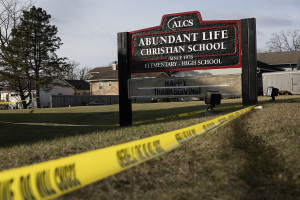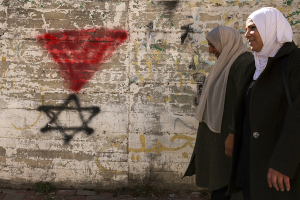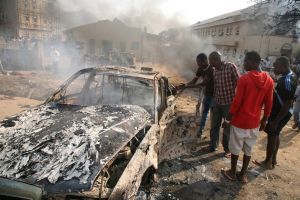There Is Still Hope for the Church: Responding to the Report on the Decline of Christianity and Catholicism in America

There has been considerable discussion on the Pew Research Center's new report titled, "America's Changing Religious Landscape." The conclusions of the report certainly seem troubling: Christians are declining as a share of the U.S. population, while those unaffiliated with any faith tradition continue to grow. The report shows that since 2007, Catholicism has seen a 3.1 percent decline, as Catholics decrease from 23.9 percent of the American population to 20.8 percent. Even more worrisome, another recent study on American adolescents' religious orientation, shows that the losses to the Christian faith are especially pronounced among our young people. This report states, "In just the 13 years between 2000 and 2013, 87 percent more college students chose no religious affiliation."
So what's next? Is Christianity dying a slow and painful death in America?
Hang on for a moment before jumping to any doomsday scenarios.
First, it must be noted that another major research organization, the Center for Applied Research in the Apostolate at Georgetown University (CARA), paints a more nuanced story of the future of Catholics in America. CARA explains that even if Catholics represent a smaller percentage of the overall U.S. population going forward, the Catholic population will continue to grow over the next 35 years. According to the most conservative projection formulas, the Catholic population will grow to more than 95 million people by 2050.
This still might not put us at ease about the fact that so many Catholics are leaving the faith or that we are becoming an increasingly secular nation. As a people committed to evangelization, who seek to share the "joy of the Gospel" with others, what can Catholics do to reverse these trends?
Cardinal Walter Kasper in his book titled, "Pope Francis' Revolution of Tenderness and Love," summarizes his take on Pope Francis' strategy for the Church. As Kasper puts it, "a self-involved church is a sick church (EG 43). Francis wants out of the stale air of a church that is self-involved—suffering from its own condition, bemoaning or celebrating itself." The Church can be healthy only when it accepts its missionary identity and becomes "a church that goes to the peripheries (EG 17, 20, 24, 30, 46)." In other words, Pope Francis does not want the Church wasting any energy on self-pity. Rather, he wants us to get out of our enclosures, where we will find the Holy Spirit already at work in the world.
This might help explain why we have seen so many people leave the Christian faith. Perhaps we have gotten out of touch with our missionary identity, which according to our Holy Father is the true life source of the Church. Without a strong missionary grounding, Christianity makes little sense.
At Catholic Extension, we are fortunate to be able to witness the missionary side of the Church, in our work to support faith communities located in poor or forgotten corners of our nation. Apart from simply providing financial support to these communities, Catholic Extension uses their inspiring stories as a means to help awaken the missionary spirit in all Catholics in America.
If you are discouraged by what you are hearing about Catholicism in the United States, I encourage you to follow Catholic Extension's work more closely. We can show you places in our nation where the Catholic Church's missionary spirit is alive and where the Church is growing.
We invite all Catholics to come and see where there are seeds of hope. Here are just a few quick examples of missionary efforts on the geographic and socio-economic peripheries where the Church in the U.S. is growing:
- You might not have thought much about the Diocese of Brownsville in Texas' Rio Grande Valley. It's worth a look. With 1.2 million Catholics, it is the most densely Catholic diocese in the country and the poorest. It is also one of the youngest Catholic Dioceses, where the median age is only the mid-twenties. Because of this immense growth, Catholic Extension has been collaborating with Bishop Flores to fund the expansion of churches throughout the diocese to accommodate the explosive growth.
- Salinas, Calif., is known as the Salad Bowl of the world, and the birthplace of Nobel and Pulitzer Prize-winning author, John Steinbeck. The lush green fields and orchards that surround this town provide the livelihood of the people, who like the characters in Steinbeck's "The Grapes of Wrath," still come to this area for low-paying agricultural jobs. The town has four parishes, each of them practically packed to capacity on Sundays, such as St. Mary's Church, where more than 6,000 people attend one of seven Masses each weekend. Catholic Extension recently funded the salaries of four missionary sisters who will reach out to the people on the periphery to ensure that the Church continues to grow in this area.
- Southern Georgia is not often considered the epicenter of U.S. Catholicism. The truth is that Georgia (along with Florida, Texas, and California) has one of the nation's fastest growing Catholic populations. Catholic Extension funds the salaries of pastors who serve rural missions here. One pastor, Fr. Freddy Angel, has seen his community grow by the hundreds in just a couple of years. In one area where there are Catholics but no church facility, he has to rent space from the Methodists to accommodate 200 people. In another place where he provides Mass, 200 people stuff in to a cramped church that scarcely seats 50. Catholic Extension is working with the diocese to help build a new church for this expanding community.
- Finally, don't overlook Alabama. Just twenty years ago, the Archdiocese of Mobile only had four parishes with Hispanic ministry, and only a few thousand Hispanic Catholics in the Archdiocese. Today, there are 25 parishes with Hispanic Ministry, and tens of thousands of Hispanic Catholics in the Archdiocese. Last month the Archdiocese convened 300 lay leaders and pastors, to craft a plan for their archbishop that will attempt to accelerate their missionary efforts.
Christians should respond to any challenging situation in the same way: with hope. The report on the decline of Christianity is eye-opening and sobering, but Pope Francis reminds us that we should never give in to the temptation to be engulfed by self-pity. The reality is that there are many opportunities to influence the continued growth of Christianity in the United States. It requires us, however, to adopt a missionary spirit, and to go to the peripheries.
Click here to learn more about Catholic Extension.





























